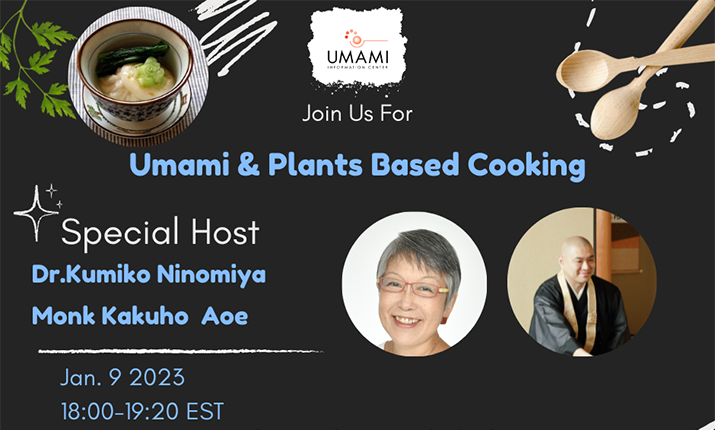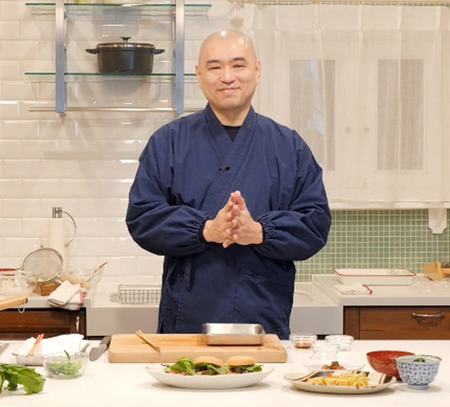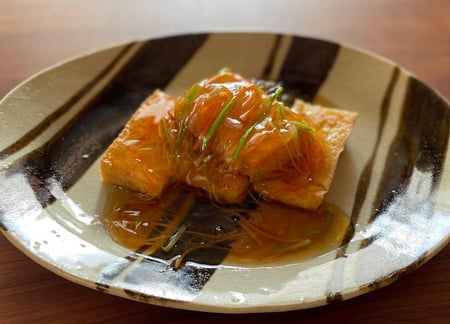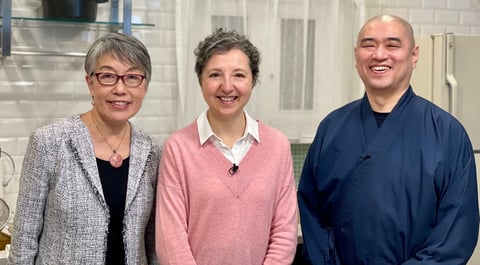UIC had “UMAMI and Plant Based Foods” webinar again
January 2023

On January 9, 2023, the Umami Information Center had a webinar introducing shojin ryori - “UMAMI and Plant Based Foods” for chefs in US.
Recently, the Western culinary world has turned its attention to the plant-based food as it is one of the SDGs. In Japan, plant-based cooking has developed for 700 years as shojin ryori. Shojin ryori cooking uses soybean-based ingredients such as tofu, abura-age (deep fried tofu-skin), and yuba (bean curd) as a source of protein. And the cooking method of shojin ryori has long been based on the effective use of umami.
UIC has chosen shojin-ryori as the theme of our webinar, as we did last year. We invited Monk Kakuho Aoe, a master monk of Ryokusenji Temple, who calls himself a "cooking monk," as our speaker this year. About 90 chefs and food industry professionals, mostly from the U.S., watched the webinar.
In the first half of the webinar, Dr. Ninomiya explained about the history and the rules of the ingredients to use in shojin ryori cooking. She also introduced the umami utilization in shojin ryori. Shojin ryori uses variety products made from soybean, which is often called as “the meat in the fields”. Dr. Ninomiya explained the nutritional value of soybeans, noting that soybeans contain more protein than other beans and that protein content of boiled soybeans is almost the same as that of meat and poultry. Dr. Ninomiya also referred to Japanese fermented seasonings using rice-koji mold, such as soy sauce, miso, and mirin, which are indispensable in shojin ryori. Umami substance glutamate is also abundant in these fermented seasonings and contributes deeply to the deliciousness of shojin ryori. She then talked about the umami substances contained in shojin dashi, which frequently uses dry ingredients. Finally, she shared some health tips including the fact that umami-based shojin ryori cooking is possible to reduce salt and be tasty at the same time.
In the second half of the webinar, Monk Aoe had a cooking demonstration, introducing the philosophy and techniques of shojin ryori, based on Buddhism. He began by explaining how to make "soy dashi," then demonstrated "miso soup," which combines soy dashi with miso, tofu, and aburaage (everything is made from soy!), and "Amakara Soybeans," which utilizes the leftover soybeans from making dashi. He also introduced "Homemade deep-fried tofu with vegetable sauce," which is made by reusing vegetable peels and stems that we would throw away. Then he introduced "Steamed turnip," which uses grated turnip liquid as dashi.
All vegetables have a life of their own.
Monk Aoe introduced chefs the philosophy of shojin ryori, a cooking method based on respect for lives of the vegetables. He told the mindset of using vegetable peels and stems, which many people would otherwise dispose of as waste. “Shojin ryori is not just a Japanese food, but also it is a chance for international foods.” said Monk Aoe. He even presented a burger made with "shojin mayonnaise," which uses tofu instead of eggs.
Click Here for the recipes.


with vegetable sauce
Monk Aoe believes that shojin ryori is gaining global attention as a cuisine that everyone can enjoy. Because shojin ryori has the most forbidden ingredients to use among the world cuisines including vegan and haral, etc.
His wonderful dishes, which fully expressed shojin ryori's technique and spirit, attracted many participants. The post-event survey showed that 76% of the participants rated the webinar as excellent and 24% as good. We got feedbacks such as “I’ve never thought to use a stock from soybeans as dashi.”, and “The history and technique of shojin ryori was very interesting and new to me”.

You can watch the webinar from the UIC Official YouTube Channel.
